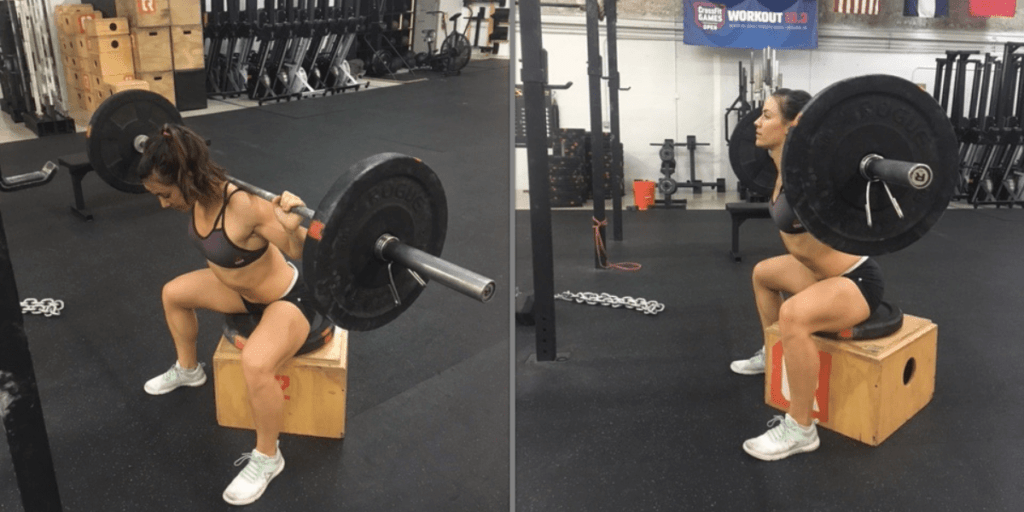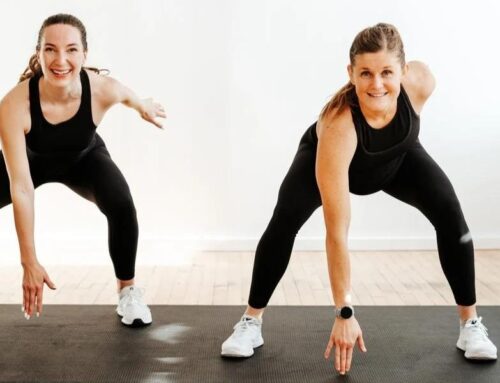
Box squats are a versatile and effective exercise that can help you build strength and power in your lower body while improving your mobility and reducing stress on your knees.
Unlike traditional back squats, box squats involve sitting back on a box or bench before standing back up, which can help you develop proper form and control while also providing variation in your training routine. However, it’s important to perform this exercise with proper form to avoid injury and get the most out of the movement.
In this article, we’ll take a closer look at how to do box squats the right way, according to trainers, as well as the benefits of this exercise for your overall fitness and well-being. Whether you’re a beginner or an experienced lifter, this article will provide you with the information you need to master box squats and achieve your fitness goals.
What Are Box Squats?
Box squats are a type of squat that involves placing a box or other object behind you before performing the squatting motion. This variation of the traditional squat can help improve your squatting form and technique, as well as provide additional benefits.
When performed correctly, box squats can help to increase your strength, power, and muscle mass. They can also help to improve your squatting technique and form. Additionally, box squats can be used as a tool to help you overcome sticking points in your traditional squat.
How To Do A Box Squat
Box squats are a great variation of the traditional back squat that can help build strength and power in your lower body. However, it’s important to perform this exercise with proper form to avoid injury and get the most out of the movement. Here’s how to do box squats the right way, according to trainers:

Step 1: Set Up
- Begin by setting up a box or bench at the appropriate height. The height of the box will depend on your individual mobility and strength level. Generally, the box should be set at a height that allows you to reach parallel depth with your thighs when you sit on it.
- Stand with your feet shoulder-width apart and your toes pointed slightly outward. Hold a barbell across your upper back, resting it on your traps and shoulders. Keep your chest up and your core tight.
Step 2: Descend
- Initiate the movement by pushing your hips back and bending your knees, as if you were sitting back onto the box behind you. Keep your weight on your heels and maintain a straight back throughout the movement.
- Descend until your glutes touch the box, keeping your shins vertical and your knees in line with your toes. Pause briefly on the box to eliminate any momentum, and then explosively drive through your feet to stand back up to the starting position.
Step 3: Repeat
- Repeat the movement for the desired number of reps, being careful to maintain proper form throughout the exercise. It’s important to control the movement and avoid bouncing off the box, as this can increase the risk of injury.
Box Squat Variations
In addition to the traditional box squat, there are several variations of this exercise that can help you target different muscles and add variety to your workouts. Here are some of the most common box squat variations:
- Wide-Stance Box Squats: This variation involves widening your stance beyond shoulder-width, which can target your inner thighs and glutes more effectively.
- Box Squat Jumps: Box squat jumps involve explosively jumping off the box after sitting back onto it, which can help improve your power and explosive strength.
- Pause Box Squats: Pause box squats involve holding the bottom position for a few seconds before standing back up, which can help you develop better control and stability.
- Banded Box Squats: Banded box squats involve adding resistance bands to the movement, which can increase the difficulty and help you build strength and power.
- One-Legged Box Squats: This advanced variation involves squatting on one leg while the other leg is extended in front of you, which can help improve your balance and stability while targeting your glutes and hamstrings.
Benefits Of Box Squats
Now that you know how to perform box squats with proper form, let’s take a look at some of the benefits of this exercise:
1. Builds Strength and Power
Box squats can help build strength and power in your lower body by targeting your glutes, hamstrings, and quadriceps. By pausing briefly on the box and eliminating any momentum, you’re forced to generate more force on the way up, which can lead to increased strength gains over time.
2. Improves Mobility
Box squats can also help improve mobility in your hips and ankles. By sitting back on the box, you’re able to work on your hip hinge pattern and develop a better range of motion in your hips. Additionally, the box serves as a guide to help you achieve proper depth without sacrificing form.
3. Reduces Stress on the Knees
Box squats can be a good option for those with knee pain or injuries, as they can help reduce stress on the knees. By sitting back onto the box, you’re able to shift some of the load onto your glutes and hamstrings, which can help take pressure off your knees.
4. Provides Variation in Training
Finally, box squats can provide a variation in your training routine, helping to keep things interesting and challenging. By incorporating different exercises and variations into your workouts, you can continue to make progress and avoid plateauing.
Tips For Doing Box Squats
These are a few tips to keep in mind when box squatting:
- Use a box or bench that’s the right height – If the box is too low, you won’t get the full benefit of the exercise. If it’s too high, you could put a strain on your knees.
- Keep your weight in your heels – This will help you keep your knees from collapsing inward, which can lead to knee injuries.
- Don’t let your knees go past your toes – This puts unnecessary strain on the joints.
- Keep your chest up and core engaged – This will help you maintain good form throughout the exercise.
Common Box Squats Mistakes To Avoid
There are a few common mistakes people make when box squatting, which can either lead to injuries or decrease the effectiveness of the exercise. These include:
- Not sitting back far enough – This puts strain on the knees and doesn’t allow you to fully activate your quads and glutes.
- Not staying balanced – Be sure to keep your weight in your heels and don’t let your knees cave inward. This will help you stay balanced and reduce the risk of injury.
- Not using a box or bench that’s the right height – If the box is too low, you won’t get the full benefit of the exercise. If it’s too high, you could put a strain on your knees.
How To Add Box Squats To Your Workout
Box squats can be a great addition to any leg workout. Here are a few ideas on how to incorporate them into your routine:
- As the main exercise – Try 3-4 sets of 8-12 reps as a primary exercise in your leg workout.
- As an accessory exercise – Try 2-3 sets of 10-15 reps after your main leg exercises.
- As a finisher – Try a circuit of 5-10 reps for 2-3 rounds as a finishing exercise to your leg workout.
No matter how you incorporate box squats into your routine, be sure to use proper form and technique to avoid injury and get the most out of the exercise.
Box Squat FAQs.
How much weight should I use for box squats?
The amount of weight you use will depend on your fitness level and goals. If you’re new to box squats, start with a lightweight and focus on using good form. As you get stronger, you can increase the amount of weight you use.
What’s the difference between a box squat and a regular squat?
A box squat is a variation of the regular squat exercise. The main difference is that you pause on a box or bench before standing back up. This pause helps to build explosive power and can also help reduce your risk of injuries.
How do I make box squats more challenging?
There are a few ways to make box squats more challenging, including using a heavier weight, holding dumbbells or a barbell in front of your chest, or increasing the box height.
Can I do box squats every day?
No, you should not do box squats every day. Like with any exercise, it’s important to give your body time to recover in between workouts. Aim for 2-3 times per week.
Box squats are a great way to build lower body strength and power. If you’re new to exercise, start with light weight and focus on using good form. As you get stronger, you can increase your weight and make the exercise more challenging. Be sure to take a day or two off in between workouts to allow your body to recover.
Conclusión
Box squats can be a valuable addition to your lower body training routine, helping to build strength, improve mobility, and reduce stress on the knees. By following proper form and incorporating this exercise into your workouts, you can continue to make progress and achieve your fitness goals.
Remember to start with a lighter weight and focus on technique before progressing to heavier loads, and always consult with a trainer or medical professional if you have any questions or concerns.



